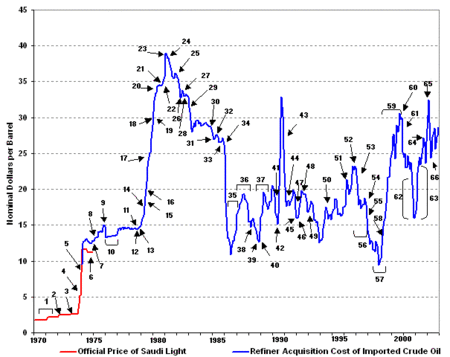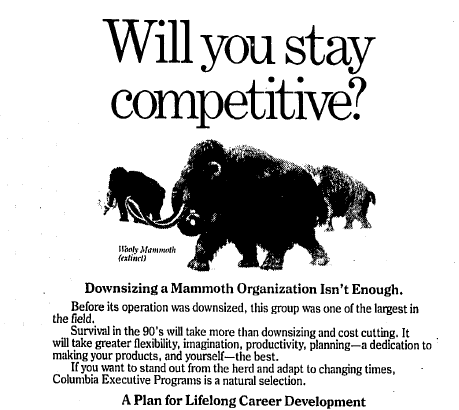January 15, 2007
Downsizing Robert Fisk's bile
In reference to Robert Fisk's screed about "jargon", Geoff Pullum speculated ("Fisk on downsizing", 1/14/2007) that
... in his hasty condemnation of the verb downsize Fisk slid from the original use to a popular extension of it, without realizing that it made what he said false: I suspect that in the "repulsive" usage of the managerial classes who talk about downsizing companies, downsize does not mean "fire". I suspect it is precisely the people who fell victim to the process by being laid off during a downsizing who coined the second meaning of the verb.
A bit of further research (it's a holiday, so I can spend my lunch as well as my breakfast on small blog-sized research projects) confirms and extends Geoff's intuition. Specifically, the use of downsize to mean "fire" is the third or fourth stage of the verb's semantic development, depending on how you count; and the available evidence supports his belief that it was the laid-off victims who originally were (and largely remain) responsible for the extension.
The OED entry for downsize starts with a note that may offer some additional insight, given Fisk's well-known anti-Americanism: "orig. and chiefly U.S.". The historical array of definitions and citations indicates that the word was first used in the automobile industry, to refer to the effects in 1974 and 1975 of the the Oil Shock of 1973:
a. trans. To design or build (a car) of smaller overall dimensions, esp. without reducing interior and boot capacity. Also absol.
1975 Automotive Industries 15 Oct. 10/1 The auto companies and their suppliers are turning to the job of ‘downsizing’ most of their cars to meet government and market demands for cars that are lighter and more economical.
1976 Time 13 Sept. 47 All the automakers are already at work down-sizing their cars for 1978 and later years. 1
I've found a couple of slightly earlier citations, taking the use in U.S. newspapers back to June of 1975. Thus "Wall Street sees more losses for car industry", Long Beach California Independent, 6/16/1975 :
GM and Ford have said they will redesign many of their large cars to make them smaller and more fuel efficient. Chrysler officials have said they, too, plan to downsize their models.
But there seems to be nothing earlier, and it's plausible that the word was invented by some unknown auto industry executive or analyst, probably in late 1974 or early 1975, once it became clear that the oil price increase was serious and more or less permanent. During the period from 1975 to 1980, there are thousands of examples of this use in American newspapers and magazines, corresponding to the reality represented by this chronology of crude oil prices:

The next step began in 1979 or so, four or five years after the auto-industry origin of the term, and involved the natural generalization of the idea of "downsizing" to other objects and products. The OED has:
b. gen. To reduce the size of. Also intr. for pass., to be reduced in size.
1979 Newsweek 19 Nov. 79 His formal announcement in Washington was similarly down-sized.
I've turned up a slightly earlier UPI citation, from The Galveston Daily News 7/4/1979:
A new line of eyeglasses has been produced especially designed for children 6 to 12 years of age to fit their smaller facial contours, rather than simply "downsized" adult models.
Other examples become commonplace from 1980 onwards, applied to hats, bags of cranberries, and construction plans, among many other things:
"Westward, ho! Hats on for the latest fashion look" Daily Intelligencer, 8/10/1980
With 3-inch brims and 5 1/2-inch crowns, the hats are a downsized version of the traditional hats with 4-inch brims and 7-inch crowns.
Deborah Hartz, "Advocate's book helps consumers buy wisely", Chicago Daily Herald, 8/13/1981
You're sure to think back to 1980, when the standard 16-ounce plastic bag of fresh cranberries was downsized to 12 ounces and sold at the same or a higher price than the traditionally sized package.
Lloyd Batzler, "'Significant problems' with jail design resolved", The Frederick Post, 8/18/1981
Mrs. Williams said the country would downsize the planned gymnasium to 3,000 square feet.
In this context, it's inevitable that people would begin to use the same term for decreasing the size of companies. You could see this as a new meaning, since decreasing the size of a company is a much more complicated thing than decreasing the size of a hat, but really, it seems to me to be just an another application of the same basic sense previously used for eyeglasses, hats, bags of cranberries, and gymnasiums.
The OED agrees, treating this usage as the same sense b given above. The earliest citations of downsizing companies or businesses are from 1982-83:
1982 Fortune 25 Jan. 7/1 Right now he's ‘downsizing’ the company, and hopes to achieve 1982 cost savings of about $600 million.
1983 Washington Post 10 June D8/4 Decline in demand for certain products and other factors ‘make it imperative to downsize the business’.
In a few minute's searching, I haven't turned up anything earlier.
The OED treats the use that bothers Robert Fisk so much in a "Draft Addition" dated June 2006:
trans. euphem. or humorous. To dismiss (a person) from employment. Freq. in pass.
with the earliest citation given being from 1990, fully 15 years after the word came into common usage as a term for making American automobiles smaller in response to rising oil prices:
1990 Communication World May-June 40/3 Communicators were facing tough times on their jobs. Many were getting downsized and outplaced.
1997 GQ Sept. 96/3 Just been downsized? Worried that someone may discover the bodies?
Both of these examples use the term as if from the perspective of people laid off, not from the perspective of those making the cuts.
A bit of web search turns up a slightly earlier use that is clearly in a quotation from someone who had been laid off -- James Barron, "Learning to Hang More than a Diploma", NYT 2/1/1990:
Nancy Wickstrom, an investment banker from Sunnyvale, S.I., who said her job was "downsized" in the aftermath of the 1987 stock market collapse, decided to go into paperhanging, because "I didn't want to go into Manhattan. I didn't want to have to wear dresses or skirts. And I wanted to be my own boss."
Ms. Wickstrom is referring to the Black Monday stock market crash of October 19, 1987. And this cartoon, from a display ad in the Wall Street Journal a year and a half earlier (8/15/1988), talks about an "operation" being downsized, but clearly plays to the fears of the individual "mammouths" whose jobs are in jeopardy in the wake of that same event, which loomed large in the consciousness of New Yorkers:

I'm sure that Geoff was right to predict that Robert Fisk "will not be very interested in the distinction between word senses that I just drew", and I expect that he will be even less interested in the further elaboration of facts in this post, despite the demonstrated connection between watershed geopolitical events and the stages in the semantic development of the verb downsize.
This is partly because Fisk, as Geoff observes, is not interested either in language or in the internet, except to complain about them. But it's also because of the same characteristic that has enabled him to give his name to a verb for providing "detailed point-by-point criticism that highlights errors, disputes the analysis of presented facts, or highlights other problems in a statement, article, or essay". The fact is that Robert Fisk appears to lack even the slightest interest in any historical, social or political facts at all. His writings are pure attitude, and the things in them that look like facts are actually examples of a completely different rhetorical category, whose definition, due to Harry Frankfurt, is worth repeating here:
What bullshit essentially misrepresents is neither the state of affairs to which it refers nor the beliefs of the speaker concerning that state of affairs. Those are what lies misrepresent, by virtue of being false. Since bullshit need not be false, it differs from lies in its misrepresentational intent. The bullshitter may not deceive us, or even intend to do so, either about the facts or about what he takes the facts to be. What he does necessarily attempt to deceive us about is his enterprise. His only indispensably distinctive characteristic is that in a certain way he misrepresents what he is up to.
This is the crux of the distinction between him and the liar. Both he and the liar represent themselves falsely as endeavoring to communicate the truth. The success of each depends upon deceiving us about that. But the fact about himself that the liar hides is that he is attempting to lead us away from a correct apprehension of reality; we are not to know that he wants us to believe something he supposes to be false. The fact about himself that the bullshitter hides, on the other hand, is that the truth-values of his statements are of no central interest to him; what we are not to understand is that his intention is neither to report the truth nor to conceal it. This does not mean that his speech is anarchically impulsive, but that the motive guiding and controlling it is unconcerned with how the things about which he speaks truly are.
It's this characteristic of Fisk's work that makes it such a juicy target for fisking, although fiskers often mistakenly assume that everything he writes is false. It's not -- but like the blind dog in Gamble Roger's story, he just don't care.
[Update: more here.]
Posted by Mark Liberman at January 15, 2007 12:53 PM